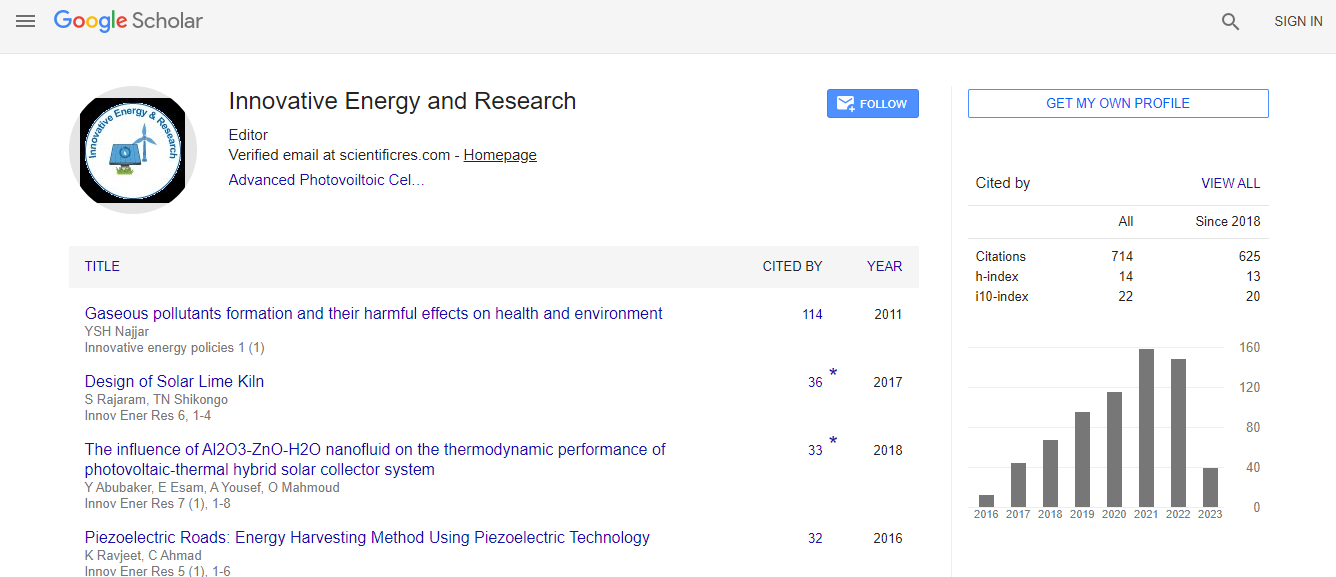Our Group organises 3000+ Global Conferenceseries Events every year across USA, Europe & Asia with support from 1000 more scientific Societies and Publishes 700+ Open Access Journals which contains over 50000 eminent personalities, reputed scientists as editorial board members.
Open Access Journals gaining more Readers and Citations
700 Journals and 15,000,000 Readers Each Journal is getting 25,000+ Readers
Google Scholar citation report
Citations : 712
Innovative Energy & Research received 712 citations as per Google Scholar report
Innovative Energy & Research peer review process verified at publons
Indexed In
- Google Scholar
- Open J Gate
- Genamics JournalSeek
- RefSeek
- Hamdard University
- EBSCO A-Z
- Publons
- Euro Pub
- ICMJE
Useful Links
Recommended Journals
Related Subjects
Share This Page
Controlling energy bandgap of semiconducting materials for energy and environment
20th International Conference on Advanced Energy Materials and Research
Hyoyoung Lee
Sungkyunkwan University, Republic of Korea
Keynote: Innov Ener Res
Abstract
A control of the energy bandgap of semicondunding metarials including transtion metal chalcogenides (TMCs) including TiO2, MoS2 and CoS2 have been paid attention for energy conversion and environmental issues. Herein, we like to introduce new findings about the visible-light driven blue TiO2 materials for photo-catalytic hydrogen evolving reaction (HER) and for an application to remove algae from water.1,2 In addition, we like to report new layered ternary transition metal chalcogenides (TTMCs) material to overcome to the limitation of active sites which is challenging in binary transition metal chalcogenides (BTMC) such as MoS2 towards electrochemical hydrogen production. The TTMC, Cu2MoS4 has been successfully synthesized by a facile solution-processed method. Moreover, by anion doping such as Se in as the synthesized Cu2MoS4, it has been found that TTMC can be exfoliated into single layer nanosheets and the single layered TTMC exhibits the highest electrocatalytic activity towards HER.3 We also report an advanced bi-functional hybrid electrocatalyst for both oxygen reduction reaction (ORR) and oxygen evolution reaction (OER), which is composed of WS2 and CNT connected via tungsten carbide (WC) bonding. WS2 sheets on the surface of CNTs provide catalytic active sites for electrocatalytic activity while the CNTs act as conduction channels and provide a large surface area. We found that four to five layers of WS2 sheets on the surface of CNTs produces excellent catalytic activity towards both ORR and OER, which is comparable to noble metals (Pt, RuO2, etc.). Our findings show the many advantages enabled by designing highly-active, durable, and cost-effective ORR and OER electrocatalysts.4 Finally, we like to demonstrate new strategy to satisfy all requirements for the development of a highly active and remarkably durable HER electrocatalyst in both acidic and alkaline media via anion-cation double substitution into a CoS2 moiety for preparing 3D mesoporous pyrite-metal vanadium-cobalt phosphorsulphide (Co1-xVxSP). Recent Publications 1. Kan Zhang, et al. (2016) An order/disorder/water junction system for highly efficient co-catalyst-free photocatalytic hydrogen generation. Energy & Environmental Science, 9, 499-503. 2. Youngmin Kim, Hee Min Hwang, Luyang Wang, Ikjoon Kim, Yeoheung Yoon and Hyoyoung Lee* (2016) Solar-light photocatalytic disinfection using crystalline/amorphous low energy bandgap reduced TiO2. Scientific Reports, 6, 25212; doi: 10.1038/srep25212. 3. Anand P. Tiwari, Doyoung Kim, Yongshin Kim, Om Prakash, and Hyoyoung Lee* (2016) Highly Active and Stable Layered Ternary Transition Metal Chalcogenide for Hydrogen Evolution Reaction. Nano Energy, 28, 366–372. 4. Anand P. Tiwari, Doyoung Kim, Yongshin Kim, and Hyoyoung Lee* (2017) Bi-functional oxygen electrocatalysis through chemical bonding of transition metal chalcogenides on conductive carbons. Advanced Energy Materials, 1602217. 5. Ngoc Quang Tran, Quoc Viet Bui, Minh Hung Le, Yoshiyuki Kawazoe and Hyoyoung Lee* (2017) Anion-Cation Double Substitution in Transition Metal Dichalcogenide to Accelerate Water Dissociation Kinetic for Electrocatalysis. Advanced Energy Materials, In-revision.Biography
Hyoyoung Lee has completed his PhD at Department of Chemistry, University of Mississippi, USA in 1997. He did his Postdoctoral studies at North Carolina State University. He worked at Electronics and Telecommunications Research Institute and then moved to Department of Chemistry, Sungkyunkwan University as a full Professor. He served as a Director of National Creative Research Initiatives. Currently, he has served as an Associate Director of Centre for Integrated Nanostructure Physics, Institute of Basic Science. His current research area is 0-2D semiconducting materials and their devices. He has written more than 140 journal articles in top-tier journals and has been serving as an Editorial Board Member of Scientific Reports.
E-mail: hyoyoung@skku.edu

 Spanish
Spanish  Chinese
Chinese  Russian
Russian  German
German  French
French  Japanese
Japanese  Portuguese
Portuguese  Hindi
Hindi 
